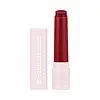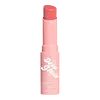What's inside
What's inside
 Key Ingredients
Key Ingredients

 Benefits
Benefits

 Concerns
Concerns

 Ingredients Side-by-side
Ingredients Side-by-side

Diisostearyl Malate
EmollientBis-Behenyl/Isostearyl/Phytosteryl Dimer Dilinoleyl Dimer Dilinoleate
EmollientBis-Diglyceryl Polyacyladipate-2
EmollientOctyldodecanol
EmollientCeresin
Emulsion StabilisingDiisostearyl Malate, Bis-Behenyl/Isostearyl/Phytosteryl Dimer Dilinoleyl Dimer Dilinoleate, Bis-Diglyceryl Polyacyladipate-2, Octyldodecanol, Ceresin, Synthetic Wax, Ethylene/Propylene Copolymer, Disteardimonium Hectorite, 1,2-Hexanediol, Propylene Carbonate, Simmondsia Chinensis Seed Oil, CI 15850, CI 15985, CI 42090
Polyglyceryl-2 Triisostearate
EmulsifyingPolybutene
Triethylhexanoin
MaskingDiisostearyl Malate
EmollientPentaerythrityl Tetraethylhexanoate
EmollientCeresin
Emulsion StabilisingDipentaerythrityl Hexahydroxystearate/Hexastearate/Hexarosinate
Skin ConditioningBis-Diglyceryl Polyacyladipate-2
EmollientPolyethylene
AbrasiveTridecyl Trimellitate
EmollientMethyl Hydrogenated Rosinate
PerfumingOctyldodecanol
EmollientTribehenin
EmollientBis-Behenyl/Isostearyl/Phytosteryl Dimer Dilinoleyl Dimer Dilinoleate
EmollientPhenyl Trimethicone
Skin ConditioningSilica
AbrasiveDicalcium Phosphate Dihydrate
AbrasiveSilica Silylate
EmollientPolyglyceryl-10 Decastearate
Skin ConditioningSynthetic Wax
AbrasiveGlyceryl Behenate
EmollientPolyglyceryl-6 Octastearate
EmulsifyingTocopheryl Acetate
AntioxidantSimmondsia Chinensis Seed Oil
EmollientGlyceryl Laurate
EmollientDisteardimonium Hectorite
StabilisingMacadamia Ternifolia Seed Oil
EmollientWater
Skin ConditioningLimnanthes Alba Seed Oil
Skin ConditioningPropylene Carbonate
SolventPolyglyceryl-2 Diisostearate
EmulsifyingSorbitan Sesquioleate
EmulsifyingGlycerin
HumectantTitanium Dioxide
Cosmetic ColorantIron Oxides
CI 77499
Cosmetic ColorantCI 15850
Cosmetic ColorantCI 45410
Cosmetic ColorantCI 15985
Cosmetic ColorantPolyglyceryl-2 Triisostearate, Polybutene, Triethylhexanoin, Diisostearyl Malate, Pentaerythrityl Tetraethylhexanoate, Ceresin, Dipentaerythrityl Hexahydroxystearate/Hexastearate/Hexarosinate, Bis-Diglyceryl Polyacyladipate-2, Polyethylene, Tridecyl Trimellitate, Methyl Hydrogenated Rosinate, Octyldodecanol, Tribehenin, Bis-Behenyl/Isostearyl/Phytosteryl Dimer Dilinoleyl Dimer Dilinoleate, Phenyl Trimethicone, Silica, Dicalcium Phosphate Dihydrate, Silica Silylate, Polyglyceryl-10 Decastearate, Synthetic Wax, Glyceryl Behenate, Polyglyceryl-6 Octastearate, Tocopheryl Acetate, Simmondsia Chinensis Seed Oil, Glyceryl Laurate, Disteardimonium Hectorite, Macadamia Ternifolia Seed Oil, Water, Limnanthes Alba Seed Oil, Propylene Carbonate, Polyglyceryl-2 Diisostearate, Sorbitan Sesquioleate, Glycerin, Titanium Dioxide, Iron Oxides, CI 77499, CI 15850, CI 45410, CI 15985
Ingredients Explained
These ingredients are found in both products.
Ingredients higher up in an ingredient list are typically present in a larger amount.
We don't have a description for Bis-Behenyl/Isostearyl/Phytosteryl Dimer Dilinoleyl Dimer Dilinoleate yet.
This ingredient is lipid-based synthetic skin-conditioning agent derived from adipic acid and a mixture of fatty acids. It is often called a lanolin substitute.
As an emollient, it helps soften and hydrate the skin. Emollients create a barrier on the skin to trap moisture in.
Due to its fatty acid base, it may not be Malassezia folliculitis safe.
Learn more about Bis-Diglyceryl Polyacyladipate-2Ceresin is a wax derived from ozokerite. It is an alternative to beeswax.
The most common process of creating ceresin is by using heat and sulfuric acid.
Ci 15850 is the pigment color red. It is an azo dye and created synthetically.
Azo dyes need to be thoroughly purified before use. This allows them to be more stable and longer-lasting.
This ingredient is common in foundations, lipsticks, and blushes. This color is described as brown/orangey red.
It has many secondary names such as Red 6 and Red 7. According to a manufacturer, Red 6 usually contains aluminum.
Learn more about CI 15850Ci 15985 is a dye made from petroleum. It is synthetically created and approved by the FDA for use in foods and cosmetics.
The color of this dye is orange/yellow.
This ingredient can be found in makeup, sun care, and skincare.
Learn more about CI 15985Diisostearyl Malate is an emollient and most often used in lip products. It comes from isostearyl alcohol, a fatty acid, and malic acid, an AHA.
As an emollient, Diisostearyl Malate helps create a thin film on your skin to trap moisture in. This helps keep your skin soft and smooth.
Disteardimonium Hectorite comes from the clay mineral named hectorite. It is used to add thickness to a product.
It can also help stabilize a product by helping to disperse other ingredients.
Hectorite is a rare, white clay mineral.
Learn more about Disteardimonium HectoriteOctyldodecanol is a fatty alcohol. It is primarily used to enhance the texture of products.
As an emulsifier, Octyldodecanol helps prevent the oils and waters from separating. It also prevents ingredients from creating foam when shaken.
Octyldodecanol is created by reducing fatty acid to an alcohol.
Due to its high molecular weight, it does not get absorbed into the skin.
Learn more about OctyldodecanolThis ingredient is a solvent. It helps dissolve active ingredients and alter the texture of products.
Propylene Carbonate is commonly used in makeup and with clay, such as montmorillonite or bentonite.
Studies show this ingredient to be safe for cosmetics. When it is undiluted, it can cause skin irritation. (It is always diluted in skincare and makeup). This ingredient is water-soluble.
Propylene Carbonate is created from propylene glycol and carbonic acid.
Learn more about Propylene CarbonateThis oil comes from the seeds of the desert shrub called Jojoba. It is more commonly known as jojoba oil, a non-comedogenic oil.
Jojoba oil does not contain fragrance and has many fatty-acids, making it a great soothing ingredient.
It also contains Vitamin E, a great moisturizing ingredient. Vitamin E is also an antioxidant and protects your skin against oxidative damage.
This ingredient humectant properties, meaning it helps draw moisture from the air. This helps keep your skin hydrated.
While jojoba has antibacterial properties, it is only able to kill some strains of bacteria.
Studies also show it helps in wound healing. In fact, Indigenous cultures have used jojoba as a moisturizer and to help treat burns for centuries.
Fun fact: Jojoba oil similar to natural human skin sebum, so it has a great effect on dry skin. It is also promising with helping to regulate sebum production.
Due to its fatty acid content, Jojoba oil may not be fungal acne safe. We recommend speaking with a professional if you have any concerns.
Learn more about Simmondsia Chinensis Seed OilSynthetic Wax is created from fossil fuels such as natural gas. It is used to enhance texture, adjust pH, and as an occlusive.
It may also be used as an abrasive ingredient to exfoliate the skin.
Synthetic Wax may not be fungal acne safe.
Learn more about Synthetic Wax